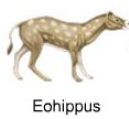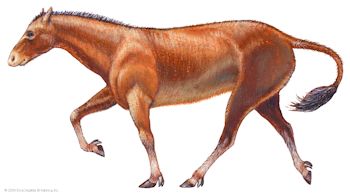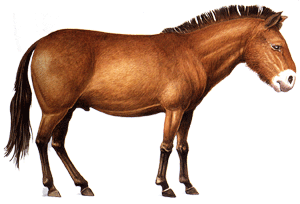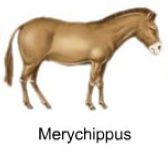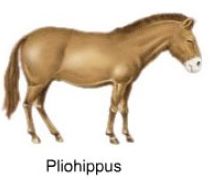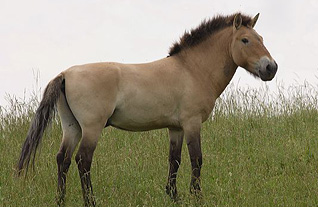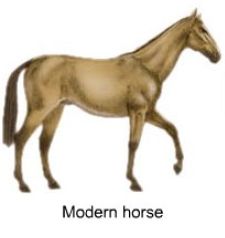The modern horse, as we know it today, has been around for about 6 million years. The early ancestor of the modern horse has been traced back sixty million years to an animal scientists call Eophippus. The first complete skeleton was found in 1931 in the Big Horn Basin in Wyoming.
The Prehistoric Horse
|
Eophippus, 60 million years ago |
|
Mesohippus, 40 million years ago |
|
Miohippus, 30 million years ago |
|
Merychippus, 20 million years ago |
|
Pliohippus, 6 million years ago |
|
Equus – Przewalski’s Horse, the only remaining wild horse that has never been tamed. Close relative of the modern horse. |
|
Equus caballus – The Modern Horse |
Kingdom: AnimaliaPhylum: Chordata Class: Mammalia Order: Perissodactyla Family: Equidae Genus: Equus Species: E. caballus |
Equus caballus Linnaeus, 1758 |
The four-toed Eophippus, 60 million years ago, was the forerunner of the first horse. He was only 14″ high. Over the next 54 million years, he evolved into the Pliohippus. This one-toed horse quadrupled in size to 48 inches. During the early period, several branches of the modern horse developed. They are the Forest Horse, Asian Wild Horse, the Tarpan Horse, and the Tundra Horse.
These were the four branches of the Equidae family that made up the Equus genus. From the Asian branch (Asinus genus) came the zebra, donkey, and onager. The ass, which looks similar to a donkey, but is larger, belongs to the Equus line, the same genus as the domesticated horse.
The Forest Horse is an extinct breed from Europe’s forests and swamplands. This horse is most likely a major contributor to the European heavy horse breeds. The “Warmblood subspecies” or “Forest Horse” (Equus ferus silvaticus, also called the Diluvial Horse), is thought to have evolved into Equus ferus germanicus, which may have contributed to the development of the warmblood horses of northern Europe, as well as the older “heavy horses” such as the Ardennais.
Warmbloods are a group of sport horse breeds and the term simply distinguishes this type of horse from the “cold bloods” (newer draft horses) and the “hot bloods” (Thoroughbreds and Arabians).
The Tarpan was a swift-moving horse from the deserts of the Middle East and North Africa. Technically, the Tarpan became extinct in 1880, but one herd is maintained in captivity in a Polish zoo. The Tarpan subspecies are a dun-colored, sturdy animal, the size of a large pony. It is adapted to the cold, dry climates of northern Asia.
The Tarpin was the predecessor to the Przewalski’s Horse, as well as the domesticated Mongolian horse. The now extinct Tundra Horse lived in Siberia and influenced the development of the Siberian Yakut pony.
Of all the domestic animals we keep today, the horse was the last to be tamed. In the early days, the wild horse was a convenient source of food for primitive peoples. The horse was probably first tamed in Eurasia about 5,000 to 6,000 years ago.
True Wild Horses
Przewalski’s Horse is the only surviving subspecies of horse that has never been domesticated. Instead of the 64 chromosomes found in the modern domestic horse, the Przewalski’s Horse has 66. These horses became known to science in 1879 when a Polish naturalist named Przewalski (pronounced zeh-val-skee) ‘discovered’ a wild herd.
They once inhabited the vast grasslands of central Asia, but beginning in the early 1900s, hunting pressure, competition for grazing land and water, and interbreeding with domestic Mongol ponies contributed to their increasing scarcity.
Despite strict legal protection in Mongolia since 1926, the species became extinct in the wild in the 1960s. In 1992, a successful breeding program that relied on captive animals was started, and the species has been reintroduced into several Mongolian national parks. In 2005, the wild populations were estimated at about 300 animals.
Ferrel Horses
The Wild Mustang found in North America, is a ferrel breed, rather than a true wild breed. Mustangs come from ancestors that were once domesticated breeds, but they were born and live wild themselves, sometimes for many generations. In the past, this order contained twelve families, but only three families have survived to the present day. They are the Equidae (the horse and related species), the Tapiridae (tapir), and Rhinocerotidae(rhinoceroses).
The Modern Horse
Modern horses come in various sizes and shapes. The draft breeds can top 19 hands (2 metres, 76 inches) while the smallest miniature horses stand as low as 5.2 hands (0.56 metres, 22 inches). The Patagonian Fallabella, usually considered the smallest horse in the world, compares in size to a German Shepherd Dog.
Today, there are more than one hundred horse breed registries, but not all of them are based on genetic lines. Some “breeds” are color breeds, which allow registration of any animal, regardless of genetic line, if they meet the color specifications of their registry.

